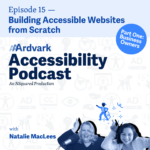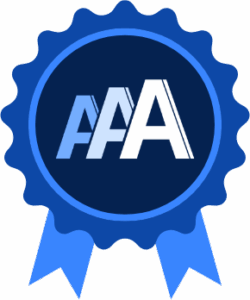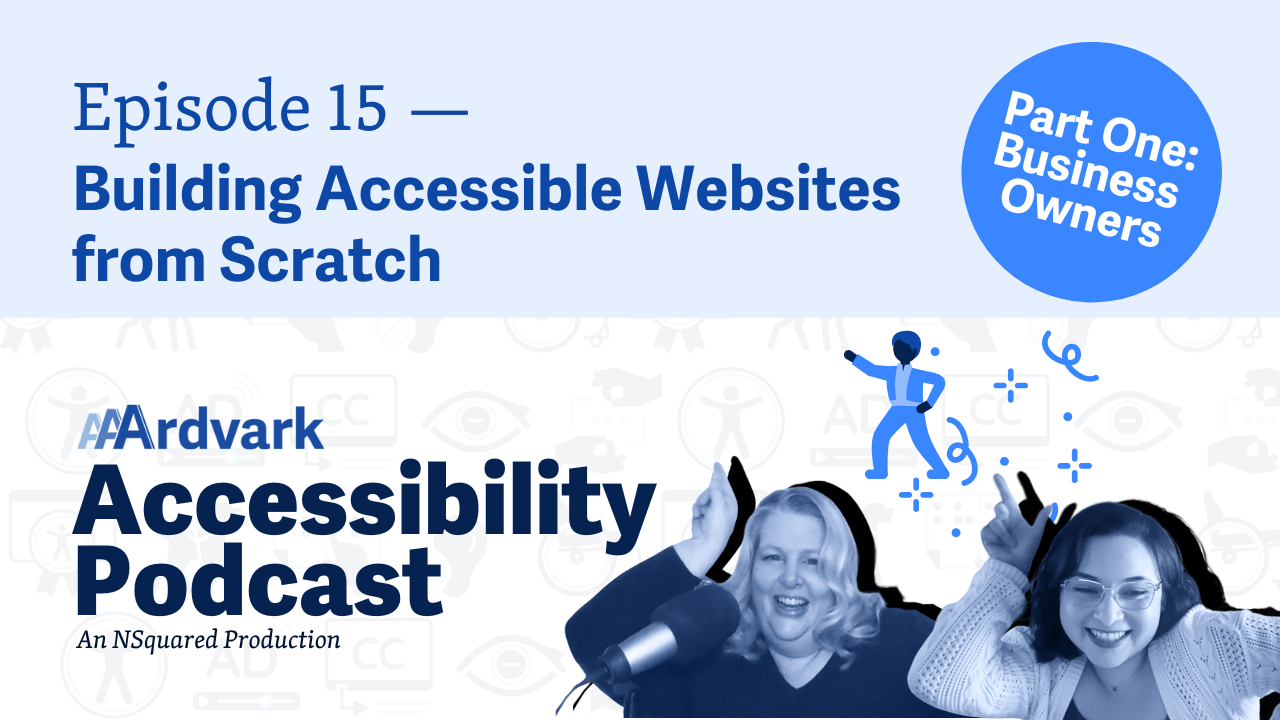
Join Natalie MacLees and Natalie Garza on the 15th episode of the AAArdvark Accessibility Podcast as they discuss the importance of web accessibility for website owners. Learn why it’s crucial to consider accessibility from the beginning of a website project, the benefits of an accessible website, and practical tips on choosing the right tools and expertise.
Natalie Garza: Hello, everybody, and welcome to the 15th episode of the AAArdvark Accessibility Podcast. My name is Natalie G, and I’m an accessibility novice, and with us today is:
Natalie MacLees: Natalie Mac, accessibility expert. (Full name is Natalie MacLees, and her nickname is Natalie Mac!)
Natalie Garza: And, in today’s episode, we are going to talk about web accessibility when building websites from scratch. So we ended up making this a two-parter. This one is gonna be geared towards website owners,
(Natalie Garza accidentally set off the built-in Apple Confetti reaction.)
Natalie MacLees: We are really excited about that.
Natalie Garza: Website owners! And the next part is gonna be geared towards developers and agencies. So to kick us off, Natalie, why is it important to build a website to be accessible from scratch?
Natalie MacLees: Oh, it’s your favorite metaphor, Natalie, from Lainey Feingold, that you cannot put the chocolate chips on the cookie after it’s baked. So if you try to build your website and then come back and try to make it accessible, it’s gonna be a nightmare. It’s not gonna be fun, and it’s probably going to at least double the cost of your website.
Because going back to a website that was built without accessibility in mind and trying to make it accessible is very difficult and very time consuming, and it could double or even triple the cost of having the website built to begin with. If you instead build an accessible website from the very, very beginning, I would say you’re probably looking at maybe about 20% more cost to have an accessible website versus an inaccessible one.
Natalie Garza: Yeah, so for one, it’s very cost-effective. But there are other benefits too.
Natalie MacLees: There’s benefits to having an accessible website. They’re more SEO friendly and who doesn’t want their site to be found in search engines? I mean, you put it online because you wanted people to find it, presumably. You can avoid legal risks, so you won’t be getting demand letters. Or if you do get a demand letter, you’ll have proof that you have been working on the accessibility of your website and it has been improving.
The overall user experience of an accessible website tends to be better. They tend to be more performant.
Having an accessible website could also increase your potential audience by up to 20% because there are between one in five and one in four, Americans who are people with disabilities. So you’re gonna capture even more of the market and potentially increase your revenue by up to 20%.
So, if your website is accessible, it just means more people can interact with it, more people can understand it, can get to all the parts of your website that you want them to interact with, like your contact forms, your checkout pages, all that good stuff.
They can get to all the good stuff and they can get to it no matter what device they happen to be using. If they’re out and about and trying to buy something from your website on their phone, it’s gonna work. If they’re at home on their laptop or their tablet, it’s gonna work.
Natalie Garza: Mm-hmm. Yeah, that’s, I think that’s a good segue to the next question. What does it mean for your site to be accessible? Do you have like an overarching definition?
Natalie MacLees: Yeah, I think roughly what a lot of people think of is that it meets WCAG guidelines, right? And we’ve dug into WCAG guidelines on other episodes, and I’m sure we’ll do it in the future. but there is things that you can do beyond the WCAG guidelines. The WCAG guidelines are really just a baseline, so there’s all different kinds of best practices you can implement, but at the end of the day,a website being accessible just means that it can be used by anybody who happens to show up with whatever device or assistive technology they happen to be using.
They’re gonna be able to use the website without any issues.
Natalie Garza: Yeah. In our last episode, we covered a little bit about myths about people who have disabilities don’t use websites. That’s not true.
Natalie MacLees: That’s not true at all.
Natalie Garza: Only certain websites need to be accessible, but that’s also not true.
Natalie MacLees: All websites should be accessible.
Natalie Garza: Mm-hmm. Mm-hmm.
Okay, So we covered why websites need to be accessible. For one, it’s the most cost-effective option. You get a bunch of benefits as a business, and most importantly, more people can access your site and use your services or understand your content. What does it mean to be accessible? It means everyone can access your site, navigate it, use it. So, how is all this tied to making website from scratch?
Natalie MacLees: Yeah, so when you’re getting started on a new website project, it is really important that you think about accessibility from the very beginning. And that’s going to impact all of the decisions that you make about the website, who you hire to build it. If you’re gonna hire somebody to build it, if you’re gonna build it yourself, you have to think about what tools are you going to use and are those accessible if somebody else is going to build it for you.
They’re probably, in this day and age, not building that completely from scratch. They’re probably using a platform like WordPress, Drupal, you know, Squarespace, they’re using something as their platform.
So if you’re hiring somebody to build it, they’re probably also using a platform or a tool that’s going to make it easier for you to update and manage content on your own later on. And you wanna make sure that that tool, whatever gets chosen, is accessible because you can’t fix that later. You have to start over again, if you’re gonna fix it later.
You can’t build a site on one platform, realize that that platform isn’t accessible, and just move it to a different platform. You can’t easily migrate sites like that between different platforms. So you’re gonna have to start over. And the only thing you might be able to skip is if you did an extensive like custom design process first, where maybe you had a designer do some branding and choose some colors, and do some mockups of some designs.
That would be the only thing that you wouldn’t have to start over on. You might even have to start over on that. If those designs weren’t accessible, if they chose colors that didn’t have enough contrast, if they chose different design components that weren’t accessible, you might even have to throw that out and start over.
So there’s lots of different ways that the different stages of building a website, you have to think about accessibility and how that’s going to come into the final product. When you do that correctly from the very, very beginning, building an accessible website is much easier, much more cost effective, but you have to make all the right decisions from the very beginning.
Natalie Garza: I mean, if you already have an existing website. You could also count a lot of the content that’s already written that could easily be migrated.
Natalie MacLees: Sure. Yeah, if nothing else that can be copied and pasted manually. Right?
Natalie Garza: Yeah, but the pages themselves, like you have to go through and recreate every single page. A lot of copy-pasting.
Natalie MacLees: Yeah. It’s a lot of copy pasting and often when a customer comes to me and says, I’ve got this website and it’s not accessible, and I wanna make it accessible. Very often it is cheaper to just start again and even if the design is all accessible and the way the site looks is fine and there’s plenty of contrast in the colors and all the different custom components and things that are designed can work in inaccessible way.
You still have to kind of start from scratch and rebuild that website. It’s faster to do if you don’t have to make a lot of design decisions and you don’t have to do all that design work. But it is faster and easier to start from scratch and rebuild a website often than trying to take something existing and make it accessible.
It just costs way more money and it’s a lot more difficult. It’s a lot more headaches.
Natalie Garza: Mm-hmm. Yeah, because even if the designer, they chose like a lot of tabs, they chose a lot of dropdown menus or what are those called? Where it’s like stacked I, they open.
Natalie MacLees: Accordions.
Natalie Garza: Accordions, yes.
Natalie MacLees: Yeah.
Natalie Garza: Or, picked really tiny font sizes for your design.
Natalie MacLees: Or put auto-playing video somewhere on the page.
Natalie Garza: Or, used a lot of tables.
Natalie MacLees: Yeah, there’s lots of unfortunate decisions that you can make in the design stage that’s going to impact the accessibility of the site later on. So you wanna be thinking about that and make sure that if you’ve hired a designer to work on your website, that it is somebody who’s versed in accessibility.
And they know how to test and check colors that they’re using for accessibility. And they have some general ideas on how content should be structured, what a form should look like. ’cause this is where things go wrong a lot of the time, is that designers will decide that having labels on form fields look sloppy or cluttered, and they take them out.
And, that is a crucial element of accessibility is to have labels for form fields. So you want somebody who knows that they can’t make those kinds of decisions so that they’re not then turning over an inaccessible design to a developer to be built, and then the developer is stuck having to say, “Well, I can’t build the form that looks like this because it’s not accessible.”
And then you have to decide, are you gonna send it back to the designer to have them redo it? Are you gonna have the developer just ad hoc try to change it? And that might not look good and it might, not mesh with the rest of the design and it gets very, very messy.
Natalie Garza: Yeah. And then I know with a lot of platforms, they also rely on like third party components.
Natalie MacLees: Yeah.
Natalie Garza: Like, WordPress is notorious for plugins and themes, but it, it’s becoming really popular across other website platforms too.
Natalie MacLees: Yeah, because the platform itself, you can’t build every type of functionality that somebody might want into a platform. You can make some pretty good guesses about functionality most people will want, right?
Like a form builder. Most websites end up having at least one form on them. But other types of functionality like appointment scheduling or newsletters, right? Not everybody’s gonna want that. And it doesn’t always make sense to build that into like a core product, but it does make sense to give people a lot of flexibility to kind of take different building blocks, right?
And put together just the functionality that they need. But then you end up in a situation where now instead of, you know, just if you have a WordPress site, instead of it just being a WordPress site, well now you have a WordPress site with functionality from 20 other random developers who built these plugins so that you can have, you know, e-commerce and you can have appointment scheduling, and you can have, all this other functionality on the site.
It’s not cohesive anymore because it’s from all different people. And do all of those developers know about accessibility? Did they all build their plugins to be accessible? Chances are they didn’t. And so you have to evaluate all of those add-ons before you add them to your site to make sure that they’re accessible.
Natalie Garza: Yeah. Which ties back to picking the right person to build your site, right? Because you can’t expect your client to know all the different plugins you’re gonna use and whether they’re accessible or not.
Natalie MacLees: Yeah, as a website owner, you’re just not gonna know those things. You’re not gonna have that kind of technical knowledge. That’s why you’re hiring somebody to help you because you need some help navigating that because it is very confusing and you can build on pretty much any of the popular platforms that are out there like right now, Squarespace, Wix, Weebly, WordPress, Drupal, or like any of those, you can build an accessible website on it, but that none of them make that particularly easy to do.
Like just a lay person with no knowledge of web accessibility probably can’t, which is unfortunate situation. It’s an unfortunate state of affairs. Somebody who does know what they’re doing, who knows about web accessibility and can evaluate all those different packages and add-ons and options that you could turn on or off in the tool.
They can get an accessible website out of that process at the end because they know how to navigate and test and figure out which things they can use and which things they can’t.
Natalie Garza: Yeah, and it’s really important ’cause down the line, like after you’ve already paid for all these plugins, all these add-ons, if the wrong person built your site. Like a year later, now you have to scrap everything, now you have to throw away all these plugins. It becomes really hard to transition.
Natalie MacLees: Or even worse, you have somebody build you a website, they do a beautiful job, it’s fully accessible, it’s working wonderfully, and then two years later you decide, “Hmm, I would like to add some functionality. I wanna sell some products, or I wanna have classes,” or something like that. And then you pick a plugin that’s not accessible to add to your website.
Well, now you’ve ruined everything.
Natalie Garza: Yeah. you lose some of the SEO benefits or expose yourself to legal risks just from adding one plugin.
Natalie MacLees: And you potentially lose some of your customers.
Natalie Garza: Mm-hmm. Yeah, you can lose some of your customers, especially if it’s really important functionality like memberships handling,
Natalie MacLees: Yeah.
Natalie Garza: e-commerce handling
Natalie MacLees: Yes. If somebody can’t check out from their cart, you’re not gonna get their money.
Natalie Garza: Mm-hmm. they’re gonna leave your site and go to another site. All right, so all in all, it’s the best option to start accessibility from the start,
Natalie MacLees: It is the best way to do it.
Natalie Garza: from scratch.
Natalie MacLees: Yes, from scratch.
Natalie Garza: Yeah. And that relies on finding the right person to do it. Making sure to ask questions along the way. Is this the right platform? Is this the right plugin, the right tools? Because later down the line you wanna switch over.
Natalie MacLees: It can be really painful, very painful, very time-consuming, and very expensive later on.
Natalie Garza: Mm-hmm. Mm-hmm. So with all that said, Natalie, where can website owners get started? Where can they go if they wanna make their sites accessible?
Natalie MacLees: They can come to aaardvarkaccessibility.com, and it can really be helpful for the process of building a website because you could actually hook up your development site or your staging site to AAArdvark. Keep an eye on it all through the development process and then keep using it on production once your site is live.
Natalie Garza: Mm-hmm. Yes. You can monitor it all the way through from staging to production and any changes in between.
Natalie MacLees: From the first line of code to the last.
Natalie Garza: Yes, from scratch.
Natalie MacLees: From scratch.
Natalie Garza: We are baking the cookie. Wait, we’re baking the chocolate chips in the cookie.
Natalie MacLees: That’s the best way to do it.
Natalie Garza: All right, so with that, that is the 15th episode of the AAArdvark Accessibility Podcast. Thank you so much to everyone for listening, and we will talk to y’all next time.


